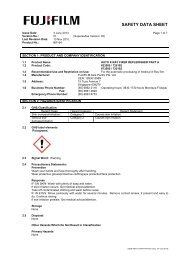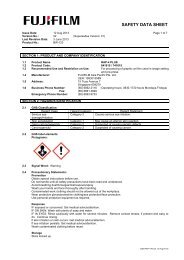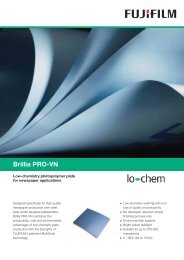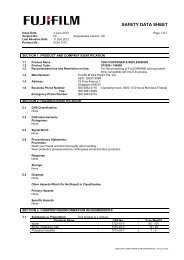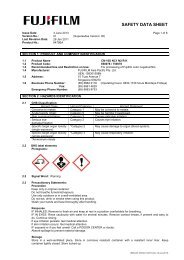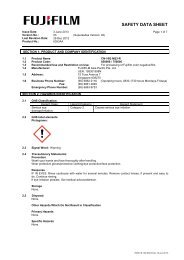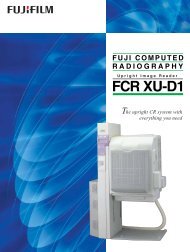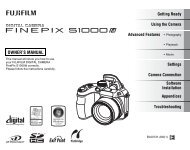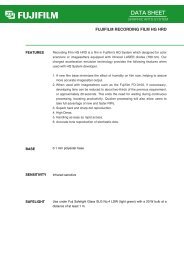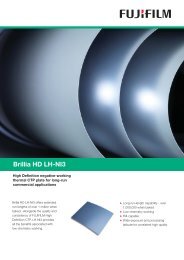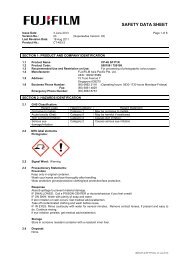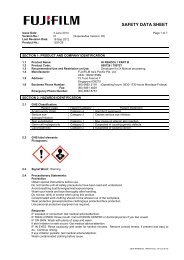The FUJIFILM Environmental Report/2001 Edition
The FUJIFILM Environmental Report/2001 Edition
The FUJIFILM Environmental Report/2001 Edition
You also want an ePaper? Increase the reach of your titles
YUMPU automatically turns print PDFs into web optimized ePapers that Google loves.
◆ Fiscal 2000 <strong>Environmental</strong> Accounting Tabulation Aggregation Chart<br />
Value unit: ¥100 million<br />
Total Environment Protection Costs Economic Effects Environment Protection Effects<br />
Volume of<br />
reduction in Converted<br />
Amount environmental monetary<br />
Category<br />
A. Area costs within<br />
businesses<br />
1) Pollution prevention<br />
Principal approach invested Cost Principal effects Amount Principal effects burden value<br />
a) Adherence to laws Maintenance and operation of facilities 3.8 18.2 Reductions of fines for 0.1 SOx reductions 125.1 tons 0.4<br />
for treating wastewater and exhaust gas (6.0%) pollution<br />
b) Pollution prevention Reduce VOC emissions 36.9 33.0 Reduce the volume 2.4 Reduction of VOC emis- 750.2 tons 3.9<br />
Reduce volume of wastewater (10.9%) of wastewater treated *1 sions into the environment<br />
2) Protection of the Progress with energy conservation 21.1 11.1 Conservation of energy *2 8.8 Reduction in the volume 51.4 tons 4.1<br />
earth’s environment Reduce the number of devices that (3.7%) of CO2 emissions into 5.1 tons @<br />
3) Resource recycling<br />
use CFCs the environment<br />
Reduction of the volume<br />
of CFCs used<br />
a) Reduce Use energy-saving designs for reducing 29.1 32.0 Reduce raw materials used 180.5 — — —<br />
energy losses during manufacturing (10.6%) per unit and conserve<br />
and for raising production efficiency resources<br />
b) Reuse/Recycle Reuse and recycle Fujicolor QuickSnap 6.0 42.4 Reduction of volume of waste 101.1 — — —<br />
single-use cameras, silver, containers, (14.0%) materials treated through 5.9<br />
and base materials reuse and recycling<br />
B. Water and sewage costs Costs for recovery from market 0.4 4.7 — — Reduction in the volume @<br />
(1.6%) of crude oil extracted<br />
Reduction in the volume<br />
of silver extracted<br />
151.6 tons @<br />
Reduction in the volume 127.2 thousand 127.2<br />
of waste for treatment at<br />
landfill sites through<br />
reuse and recycling<br />
tons<br />
Reduction in the volume of 208.4 thousand 0.8<br />
water used by customers tons<br />
Reduction in the volume of 5.8 thousand<br />
waste liquids by customers tons<br />
C. Costs of management <strong>Environmental</strong> protection activities 0.4 20.8 — — — — —<br />
activities at production sites<br />
Costs for obtaining ISO 14001<br />
certification<br />
Costs for publicizing information<br />
(6.9%)<br />
D. Research and Development of environment- 18.9 140.2 — — — — —<br />
development costs friendly products<br />
R&D of environment-friendly facilities<br />
that reduce energy losses<br />
Testing of material safety<br />
(46.2%)<br />
E. Social-related activities Beautification and 0.1 0.2 — — — — —<br />
greenification activities (0.1%)<br />
F. <strong>Environmental</strong> damage Fines for environmental pollution — 0.6 — — — — —<br />
costs (0.2%)<br />
Total 116.7 303.2<br />
(100%)<br />
298.8 139.7<br />
*4<br />
3.3 *5<br />
113.1 thousand kl *3<br />
Categories with @ do not list monetary values because there are no indicators enabling a conversion into monetary amounts.<br />
*1 Volume reduced: 1,218,000 tons<br />
*2 Portion of reduction of heavy crude: 26.7 thousand kl<br />
*3 Portion of reduction of heavy crude: 89.1 thousand kl<br />
Portion of reduction of plastic waste materials: 24.0 thousand tons<br />
*4 Alumina waste materials: 47.5 thousand tons<br />
Plastic waste materials: 11.9 thousand tons<br />
Other waste materials: 61.9 thousand tons<br />
Volume of reductions of waste material disposed of through incineration and landfill sites: 5.9 thousand tons<br />
*5 Development liquids: 2.8 thousand tons<br />
Sticking agents: 3.0 thousand tons<br />
<strong>The</strong> bases for converting reductions in the environmental burden into monetary values are as follows:<br />
1. SOx reductions: ¥345 thousand/ton (Industrial <strong>Environmental</strong> Management Association Co., Ltd., from Fiscal 1999 <strong>Report</strong> on Survey Research (<strong>Environmental</strong> Auditing), including on Development of<br />
<strong>Environmental</strong> Business.)<br />
2. VOC reductions: ¥525 thousand/ton (Industrial <strong>Environmental</strong> Management Association Co., Ltd., from Fiscal 1999 <strong>Report</strong> on Survey Research (<strong>Environmental</strong> Auditing), including on Development of<br />
<strong>Environmental</strong> Business.)<br />
3. CO2 reductions: ¥8,000/ton (Average cost for joint implementation (AIJ) Project based on the United Nations Framework Treaty for Climate Changes)<br />
4. Landfill treatment costs for industrial waste: ¥100/kg<br />
5. Water purifying treatment costs: ¥400/ton (Calculated based on drinking water costs and sewage costs for local government authorities)<br />
6. Unit costs for the treatment of development agents: ¥65 thousand/ton<br />
Unit costs for the treatment of fixing agents: ¥50,000/ton<br />
17



